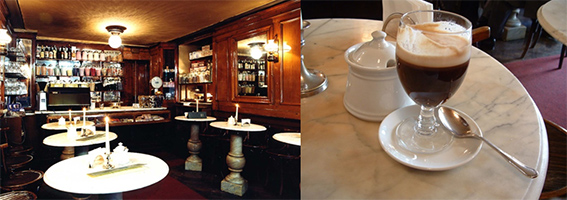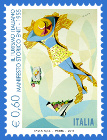The historic caffés in Turin

Turin has an innate aristocratic elegance you can breathe by wandering across the tidy checkerboard grid of the streets while looking at the splendour at the Baroque palazzoes. It’s very likely you’ll come across the ancient Caffé of the city and you’ll want to flatten your nose on the windows to absorb the beauty of the décor, the polished boiseries, the richly crafted sofas, and you will be suddenly feel you crossed a time gate.
Here I am going to introduce you to some -but not all!- of the most characteristic caffés of the old city centre.
Caffés would mostly serve alcohol-free drinks with coffee and chocolate base. Turin prides itself by having one of the most antique traditions in chocolate making in Europe (but that’s another story…) and coffee wasn’t the espresso you would order at the bar and drop it on your throat in a jiffy before you run to work…It was much more like tea time in UK, with gentlemen sitting around fashionable tables, polished china cups and tiny patisserie on the trays, while reading newspapers and talking about politics.
But let’s start from the beginning, since the first Caffé (note that it is not written Cafè which is the French word…) in the Italian peninsula was the Florian in Venice in 1720, Caffé Fiorio was inaugurated in 1780 under the porticoes of Via Po, the street leading to the largest Italian river, when Turin was the capital of the Piedmont and Sardinia Kingdom. Caffé Fiorio would host the most high profile conservative politicians and intellectuals. Nowadays the main room of Fiorio is in a splendid Art Deco style, while the back rooms kept a XIX century atmosphere.
Baratti&Milano is one of the most representative caffés of the understated splendour of Turinese aristocracy: its windows face the porticoes of the main square Piazza Castello and the Art Nouveau Subalpina gallery, allowing to be half-seen gilded wooden boiseries and decorated glazed glasses with the list of the liqueurs the bar would offer to its clients.
Very close to Baratti&Milano you can walk and step in caffé Mulassano. The beauty of the Art Nouveau decorations is even more enhanced by the small dimension of this place: just one small main room with a large counter where you can take your espresso coffee. Indeed, Mulassano opened in 1930, when the Espresso was invented already…guess where?...Here in Torino! (but -again- that’s another story...).
In Piazza San Carlo (St. Carlo square) the Neoclassic caffé San Carlo was the seat of the Liberals during the Italian Independence wars, in opposition to the Conservatives’ caffé Fiorio. The Huge Murano blown glass chandelier is worth the visit! By walking further you’ll come across the large Martini light billboard in front of the caffé Torino, another Art Nouveau jewel of the city… and, by the way, Martini is a Turin company since Vermouth was invented here...
Last but not least, I would walk you a little bit further from the aristocratic centre of the city amongst the medieval narrow streets of the Quadrilatero district to caffé Bicerin. By crossing the entrance door is like jumping with both feet two centuries back, when Count Camillo Benso, Prime Minster of the Savoy Kingdom, would come over to enjoy a “bicerin”, the warm chocolate, cream and coffee drink invented here for him and becoming one of the gastronomy signatures of Turin.
Contact us to design your own itinerary!
 Written by Natalia Ladecka-Papadogona
Written by Natalia Ladecka-Papadogona













